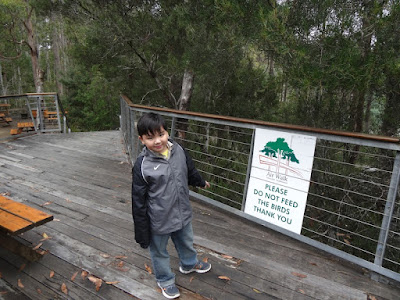The morning of March 18, 2014, found Eileen, Ryan and I looking down from the viewing platform on the heights of Mount Wellington. I was last here forty years earlier, in 1974, and I still think it is the best way to start a visit to Tasmania.
Below us, in the mist, lay the city of Hobart and the estuary of the Derwent River - still a fine view, even on a damp and foggy day.
Behind us stood the Pinnacle, an impressive pile of rocks, 1270 metres above the Tasman Sea.
Was there a drawback? Well, yes; it was cold up there. The winds bit at us - we were, obviously, a long way from Malaysia!
The combination of cold and wind create ideal conditions for the growth of alpine heathland and low scrub, the plant community that covers much of the summit. Tasmania has a fascinating flora, with over 500 species found nowhere else. A good many of them grow in the vicinity of the mountain.
Fire has altered the plant composition on the summit. It has eliminated some sensitive species, but has benefited Kerosene Bush (Ozothamnus ledifolius), a composite which now the dominant plant in the alpine scrub.
March is well outside the flowering season in Tasmania, but there were still a few things in bloom. This appears to be Common Fireweed or Fire Groundsel (Senecio linearifolius), a widespread southeastern Australian species and a common roadside plant in Tasmania.
Numerous lichens, some quite attractive, grew on bare rocks that thrust above the scrub.
Finally, the cold got the better of us. We started on our way down, dropping below the treeline and driving through the forest that covers the lower slopes of the mountain.
We devoted the rest of the day to an excursion south of Hobart, with our eventual goal being the forests of the Huon Valley. Our route took us through Tasmania's apple-growing country, and along the long, narrow estuary of the Huon River, dotted with sailboats, before we turned west along Arve Road towards the upper reaches of the Huon and the famous, and much-publicized, Tahune Airwalk.
The plant life here could not have been more different from the treeless slopes of Mount Wellington. This is the land of the Mountain Ash (Eucalyptus regnans), the tallest flowering tree in the world and a rival for the tallest of all trees, the redwoods of California.
The Huon Valley, however, is not pristine forest. The trees have been logged, and I was disappointed in my hope to show Ryan something akin to the giants I had seen near Lake Pedder, in Tasmania's far southwest, back in 1974. Besides, the track to the biggest tree in the valley was, alas, closed (though we could glimpse it from the car).
Mind you, these were still pretty big trees.
Besides, it was raining once we reached the bridge over the Huon River that leads to the Airwalk. We decided, therefore, to forgo paying the rather hefty fee for the privilege of slipping about on an elevated, rain-soaked steel walkway. Instead, Eileen decided to relax in the car while Ryan and I poked around a bit (for free) at ground level.
Here, at least, I could photograph the almost shockingly purple berries of Tasmanian Flax Lily (Dianella tasmanica)...
...and get on close terms with a Black Currawong (Strepera fuliginosa) perched on the sign at the Airwalk entrance. This is one of the more approachable of the eleven bird species endemic to Tasmania, where it replaces the widespread Pied Currawong (S. graculina) of the mainland.
It presumably expected a handout from us; obviously it was incapable of reading this sign (or it could read it, but hoped that human visitors to the area would include some generous illiterates).
With that, we headed back to Hobart. As we drove up the estuary again the clouds cleared, and a rainbow promised us (despite Tasmania's reputation for dampness) better weather to come.

























The landscapes are beautiful! I'm eager to see what endemic species you encountered on the trip.
ReplyDeleteWell, I did see a few so stay posted - though not as many as in 1974 when I was birding full-time.
ReplyDeleteGlad to know you're still reading - I gather I missed you by a few minutes at the sustainability fair in Singapore last year. Maybe next time I'm in town?
Do you mean the Festival of Biodeversity? If so, what a pity! I did not stay there long... Do sound me out the next time you come here!
DeleteYes, that was the one - we'll certainly have to do better next time!
ReplyDelete